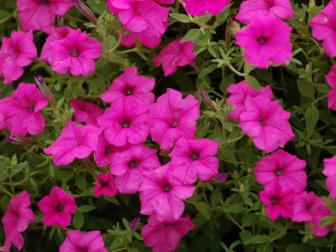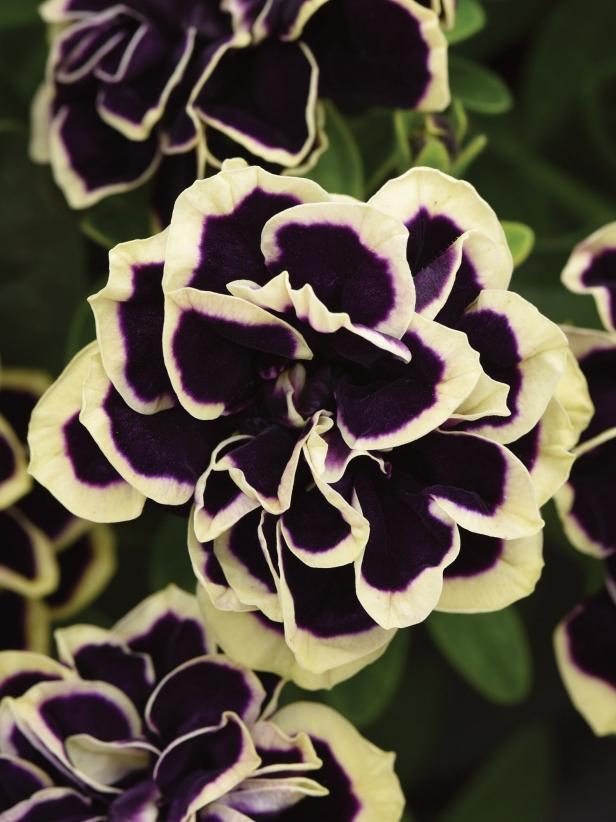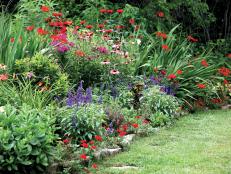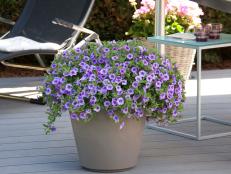Petunia Flowers: Planting and Caring for Petunias
Easy-care petunias can't get enough of the sun. Learn how to grow petunia flowers in pots, hanging baskets or beds for vibrant summer color and get tips on how to care for wilting petunias.
Color your garden with the wonderful world of petunias. These fabulous favorites open flowers in every color but brown. You can find blooms in pale pastel hues, black and even the botanically elusive blue. Newer petunia introductions bring playful personalities to the garden with blossoms boasting one hue ringed in a contrasting shade at the edges.
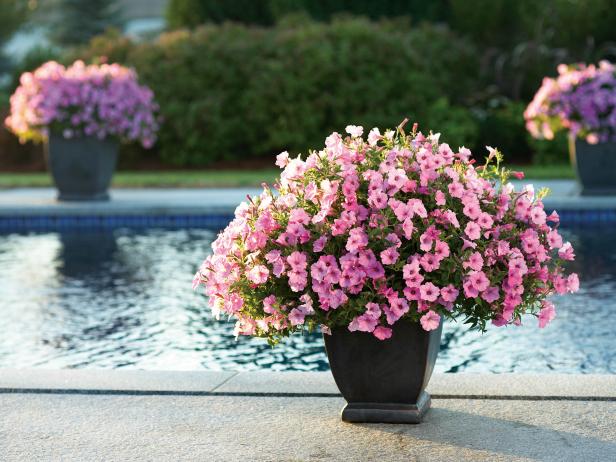
Proven Winners/www.provenwinners.com
Petunias are tender perennials in Zones 9-11 but are typically grown as annuals in all zones.
All About Petunias
Height: 6 inches to 18 inches
Spread: 18 inches to 4 feet
Flower Size: 1 inch in diameter to 5 or 6 inches
Hardiness Zones: Tender perennials in Zones 9-11, typically grown as annuals in all zones
Grandiflora types have large blooms and are often used in hanging baskets and pots for maximum impact; multiflora types have more abundant, but smaller, blooms and are typically used in landscaping beds.
Petunia plants are easy to please and fill containers and planting beds alike with a season-long show.
Petunias also attract butterflies.
12 Varieties of Petunias to Consider 11 Photos
Petunia flowers add pop to any garden. Choose from these popular varieties.
How to Plant Petunias
When to Plant
Plant petunias whenever they're displayed for sale at local garden centers, starting in spring. In hottest parts of the country, get petunias planted while days are still cool so they're fully established before heat arrives. Pinch petunias as you plant to encourage branching.
Soil
There's no need to spend intense effort on soil prep. These pretty bloomers thrive in average soil as long as it drains well. If your soil is heavy clay, amend with plenty of organic matter or build raised beds to give petunias the drainage they crave. In planting beds and containers, blend a slow release fertilizer into soil prior to planting according to suggested rates on the fertilizer package.
When planting in beds, leave a foot in between the plants as the petunias will spread and fill in the empty space.
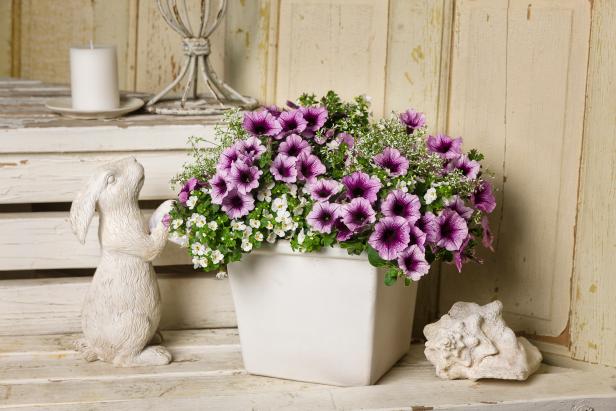
ProvenWinners.com
Supertunia Bordeaux petunias are planted with Snowstorm Snow Globe bacopa and euphorbia Diamond Frost in this container "recipe" called Last Tango in Paris.
When growing in containers, make sure you leave room for growth and spreading. Containers will dry out faster than a traditional bed, so you'll need to water the petunias more often. Also, make sure your containers have good drainage to let excess water run out.
Sun
Full sun coaxes the most flowers out of plants, but you'll still see a strong show with most types in areas with a little shade for part of the day. With containers, light shade during the hottest part of the day can be helpful, especially as summer wears on and daily watering isn't enough to slake potted petunias' thirst.
How to Care for Petunias
Watering
Petunias can take summer heat in even the warmest regions, but you'll need to water plants consistently to keep the flowers coming. In landscape plantings, water spreading petunias, such as Wave or Supertunia types, a few times a week once summer heat arrives. These plants can grow up to a foot a day in ideal conditions, and they need sufficient water to fuel that intense growth.
Other petunias can get by with less frequent watering — maybe twice a week in southern areas and weekly in cooler northern zones.
Fertilizing
Spreading petunias have humongous appetites. Feed them weekly in planting beds and pots with water soluble fertilizer. Fish emulsion is a good natural choice. In containers, try a bloom booster fertilizer. Look up your specific petunia type online to learn if you need to remove spent flowers. With many of the newer petunias, plants are self-cleaning.
Maintenance
If your petunias start looking a little ratty in midsummer, give them a trim. Remove up to 20% of total growth — either in length or number of stems. Fertilize plants after trimming to jump-start new growth. Depending on where you live, you might need to repeat the process in late August, especially if petunias usually grow well into fall in your region.
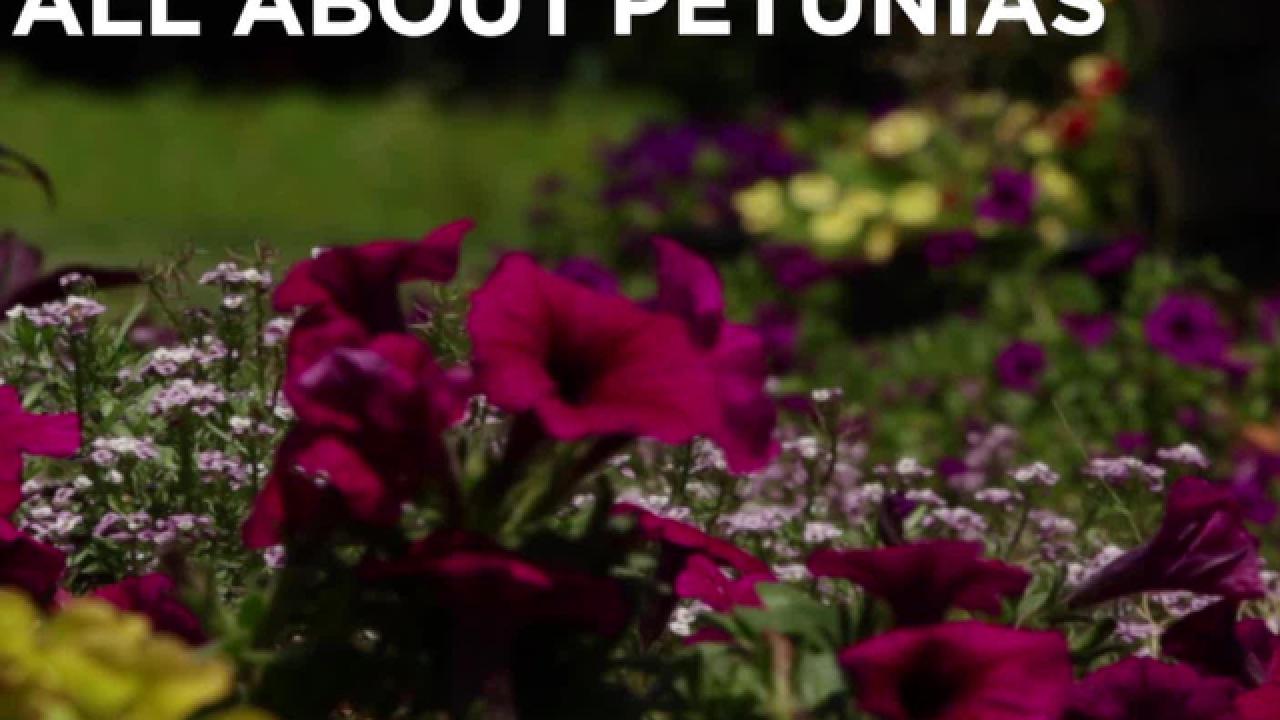
Troubleshooting Petunia Problems
Why Are My Petunias Wilting?
Despite the fact that petunias are practically perfect with their terrific color selection and non-stop flower show, many gardeners experience one common problem: wilting. Often the entire plant wilts, and you're left to figure out what has happened and — more importantly — if it can be fixed.
Several common situations occur that trigger wilting in petunias. Use this list to troubleshoot your own petunia problems and then follow our advice for reviving your petunias.
Why Petunias Wilt
Too little water. If the soil where a petunia is growing dries out, the plant's roots won't be able to absorb any moisture to keep leaves and stems from wilting. Soil might be too dry because it's hot and there's been no rain or you haven't watered enough. Petunias in windy conditions, especially those in hanging baskets, dry out quickly. Soil that's sandy also tends to dry out faster than soil that's high in organic matter. A petunia that's planted in a pot that's too small also tends to wilt more often because the small amount of soil dries out quickly.
Too much water. When soil is too wet, petunias wilt. This happens because roots need air to breathe and grow properly. Healthy soil is made of different size particles that create minute air pockets that are just right for roots. In saturated soil, roots literally drown because all those air pockets fill up with water and there's no air available for roots. Reasons that soil becomes too wet include watering too often, not having drainage holes in containers to let excess water drain away or soil with a high clay content. When soil is too wet, too often, it can lead to a disease known as root rot — the roots literally rot away because they're submerged in water. When a plant has root rot, the soil has a sour, sewer gas-type odor.
Heat stress. This typically occurs in newly planted petunias that haven't developed an extensive root system before a hot spell strikes. In this case, the new transplants don't have the ability to take up enough water to keep the plant from wilting. Established petunia plants may wilt in the heat of the day, especially during a hot spell and definitely when heat combines with drought. This type of wilting isn't a problem if plants revive overnight or once they're no longer in direct sun.
Compacted soil. If soil becomes compacted and those tiny air pockets disappear, this creates the same conditions as soil that's too wet. Also, the roots of petunias planted into compacted soil have a tough time penetrating soil. This means plant roots hover near the soil surface, which tends to dry out quickly. In this situation, it's tough to water enough to prevent wilting or to avoid overwatering. Compacted soil can occur when you use garden soil in containers (instead of a mix designed for containers), when you don't mix organic matter into planting beds that have been walked on frequently or when you re-use soil in containers for many years over time.
How to Revive Petunias
Sometimes you can revive a wilted petunia — other times you can't. If petunia stems have wilted to the point that they're dry and brittle, that plant is beyond hope. Here are a few tips to try and nurse your plant back to life.
Soil that's too wet. Let soil dry out. If petunias stay wilted when soil is dry, remove the soil and replace it. In planting beds, add compost to soil to help loosen it (You might have to dig up the petunias, amend the soil and replant the petunias.). With containers, discard the too-wet soil (especially if it has a sewer gas-type smell), and replant your petunias into fresh potting mix designed for use in containers.
Soil that's too dry. Adjust watering so you're not watering too lightly. A quick pass of the hose isn't enough water. You want to soak soil deeply with each watering. In pots, water to cover the exposed soil completely, let that soak in, and repeat until water leaks from the drainage holes.
Replace soil. If a petunia in a container has wilted but other plants in the same pot look fine, dig up and discard the petunia and the soil immediately around and under it. Add fresh potting mix designed for container use and replant a new petunia.
Heat stress. When first planting petunias in containers, stash them in a semi-shady spot to help reduce heat-induced wilting. Shift the pot to a full sun location when plants start pushing new growth.
‘Midnight Gold’ attracts attention with elaborate deep-royal purple double blooms with light-gold tips.







